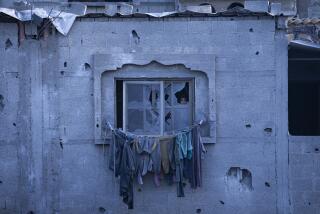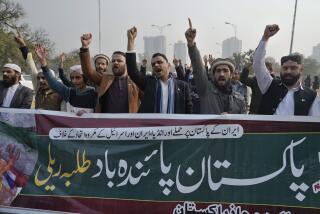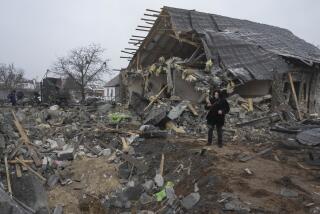Pakistan’s Economy Suffers Blow
- Share via
ISLAMABAD, Pakistan — A longtime New York resident and former Citibank executive, Pakistani Finance Minister Shaukat Aziz felt last month’s attacks on the U.S. as a personal blow.
“My wife watched the two buildings fall from the bedroom window of our Manhattan apartment,” he said in an interview here. “It was a terrible tragedy.”
Now Aziz, who’s ending his second year as chief of this nation’s economy, faces the challenge of repairing the collateral damage stemming from Pakistan’s front-line position in the international campaign against terrorism.
Since Sept. 11, economists here estimate, exports have dropped by more than 50% as most international airlines that serve Pakistan have canceled their flights. Freight and insurance charges are up sharply. The stock market in Karachi, the commercial capital, fell 13% in just one week.
In addition, the government faces extra costs from increased security along the country’s 1,500-mile border with Afghanistan and around foreign diplomatic missions and aid agencies.
But even as Pakistan’s fragile economy teeters, other governments are scrambling to prop it up. President Pervez Musharraf’s decision last month to join the U.S.-led anti-terrorism coalition put him on a political tightrope at home but won him many new friends internationally.
“Since President Musharraf’s decision, many countries, including the United States, have worked very hard to find ways of shoring up the Pakistan economy,” said U.S. Ambassador Wendy Chamberlin.
Days after the Sept. 11 attacks, the Bush administration lifted economic sanctions that had been imposed on Pakistan because of its nuclear weapons program.
Then, bypassing further sanctions placed on the country after the 1999 military coup that put Musharraf in power, the Bush administration awarded Pakistan $50 million in direct foreign aid. Another $50 million is expected soon. Meanwhile, Congress is considering legislation that would waive the later sanctions entirely, clearing the way for as much as $600 million in direct aid.
The United States, Japan and other creditor nations have opened discussions on rescheduling or forgiving some of Pakistan’s $12.5-billion government debt. This marks one of the first times Tokyo has used the word “forgive” in addressing bilateral debt.
Washington is also considering policies that would increase Pakistan’s access to U.S. markets. As it is, the United States accounts for about 85% of Pakistan’s important textile and manufactured garment sales.
Aziz, who is scheduled to travel to Washington on Wednesday to meet with Treasury Secretary Paul H. O’Neill, is likely to find a receptive audience for his appeals for investment and financial support. Central to the talks will be the question of whether the U.S. is willing to restructure or forgive Pakistan’s $3-billion debt to the United States.
The urbane, 52-year-old Aziz, known for his tailored suits, crisp blue shirts and rep ties, is already a favorite of Western governments because of the economic reforms he instituted after Musharraf appointed him in November 1999. A European publication recently named him “Finance Minister of the Year.”
Those reforms included meeting the strict standards of an austerity regimen ordered by the International Monetary Fund.
Before the attacks on the U.S., Aziz says, Pakistan’s economy was showing signs of renewed life.
“As we entered the crisis,” he said, “most of the macro indicators were good. Our foreign reserves at $3.3 billion were the highest we’ve had in a while. We had low inflation. We had a reduction in our fiscal deficit and an improvement in our balance of payments. We were expecting a 4% growth rate compared to 2.6% last fiscal year.”
Still, Pakistan remains an extremely poor country. Its per capita annual income is only $470 for a population of 140 million, ranking it 160th in the world and only slightly higher than neighboring India. Pakistan’s total foreign debt is more than $34 billion.
Direct foreign investment, never particularly high, declined steadily from $2 billion in the early 1990s to less than $400 million last year.
Said a U.S. diplomat here: “When an investor is looking where to put their money, Pakistan is not at the top of their list. It has sectarian violence and the image of an extremist state because of its ties to the Taliban,” the ruling fundamentalist Islamic movement in Afghanistan.
A change in that image could end up being one of the benefits of the crisis brought on by last month’s attacks. By breaking with the Taliban regime--which is harboring suspected terrorist mastermind Osama bin Laden--the Musharraf government sent a message to the world that is likely to pay off when Aziz visits New York and Washington this week.
“I don’t want anybody to feel that we took a political stand to help us on other issues,” Aziz said. “Pakistan’s position was not based on any quid pro quo.
“But naturally, as our relations get closer to our coalition partners, they will become aware of the problems we face. We have debt problems, and we need investment and donor money to grow our economy and build our infrastructure.”
More to Read
Sign up for Essential California
The most important California stories and recommendations in your inbox every morning.
You may occasionally receive promotional content from the Los Angeles Times.













